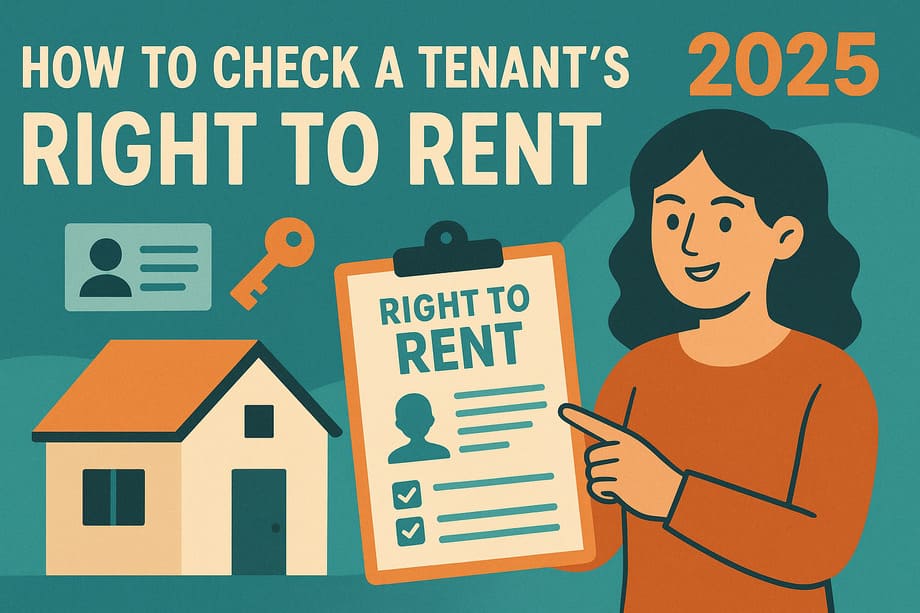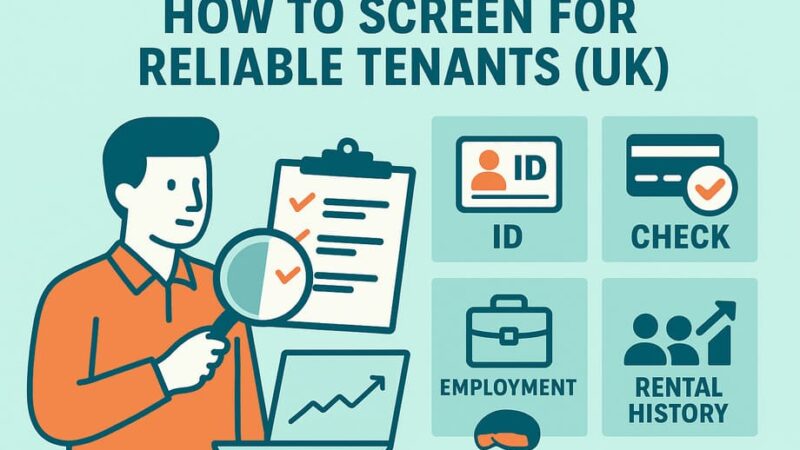How to Check a Tenant’s Right to Rent – Complete Guide for UK Landlords

Checking a tenant’s right to rent is a mandatory legal requirement for landlords and letting agents in England. This guide explains what right to rent checks involve, who must carry them out, which documents qualify as proof, and the penalties for non-compliance.
Understanding how to properly verify your tenants’ immigration status protects you from substantial fines, potential prosecution, and ensures you meet your legal obligations under UK law.
What Is a Right to Rent Check?
A right to rent check is the legal process of verifying that prospective tenants have permission to reside in the United Kingdom before allowing them to occupy your rental property. This involves examining specific identity and immigration documents to confirm that each adult tenant possesses the lawful right to live in England.
The right to rent scheme was introduced through the Immigration Act 2014 and has been compulsory for all landlords throughout England since February 2016. You must establish whether your tenant has unlimited right to rent (permanent permission) or time-limited right to rent (temporary permission with an expiry date).
The regulations apply exclusively to England. Landlords in Scotland, Wales, or Northern Ireland currently face no obligation to perform right to rent checks.
Who Must Conduct Right to Rent Checks?
The legal responsibility for completing right to rent checks falls on:
Private Landlords: Anyone renting residential property must conduct these checks or delegate the task to an authorized representative.
Letting Agents: Professional agents can perform verification on behalf of landlords, but this arrangement must be documented in writing.
Subletters: Tenants who sublet their property become responsible for checking their subtenants’ right to rent.
Resident Landlords: If you take in lodgers, you must verify each lodger’s right to rent.
The law makes no exceptions based on property size, rental duration, or tenant nationality. Every landlord in England must check every adult occupant.
When Should You Perform Right to Rent Checks?
Initial Checks
For tenants with permanent right to rent, you may conduct your check at any point before the tenancy commences. However, if your prospective tenant holds only time-limited permission to stay in the UK, you must complete your check within 28 days before the tenancy start date.
Follow-Up Checks
When tenants possess time-limited right to rent, you must conduct follow-up verification either before their permission expires or within 12 months of your previous check, whichever comes later. Failing to complete follow-up checks exposes you to the same penalties as not conducting initial checks.
Who Needs Right to Rent Verification?
Right to rent checks apply to every individual aged 18 or older who will occupy your property as their primary residence. This includes:
- All adult tenants, whether named on the tenancy agreement or not
- Partners, adult children, or household members not party to the rental contract
- New adults who move in during an ongoing tenancy
- Lodgers and subtenants
Children under 18 do not require checking. If they turn 18 during the tenancy, you need not check them at that time, but should include them in future follow-up checks if required.
Anti-Discrimination Requirements
You must verify every adult tenant using exactly the same process, regardless of their apparent nationality, ethnic origin, or whether you believe them to be British citizens. Selectively checking only those you suspect might be foreign nationals constitutes illegal discrimination.
Acceptable Documents for Right to Rent
Documents for British and Irish Citizens
British and Irish citizens can demonstrate their right to rent using:
British Citizens:
- Current or expired British passport
- Certificate of registration or naturalization as a British citizen
- Birth or adoption certificate issued in the UK, plus an official document showing their National Insurance number
Irish Citizens:
- Current or expired Irish passport or passport card
- Birth or adoption certificate issued in Ireland, plus proof of National Insurance number
British and Irish citizens cannot generate share codes. You must check their physical documents in person or use a government-certified Identity Service Provider.
Documents for Non-British and Non-Irish Citizens
Foreign nationals can prove their right to rent through:
Share Code System: Many foreign nationals can generate a share code through the government’s online system. This is available for those who:
- Hold a biometric residence permit or card
- Have settled or pre-settled status under the EU Settlement Scheme
- Applied for a visa using the UK Immigration ID Check app
Physical Documents:
- Current passport endorsed with UK immigration permission
- Current biometric residence permit
- Current residence card issued under EU regulations
- Current immigration status document containing a photograph
Alternative Documentation
In specific circumstances, tenants may use alternative documents when they cannot provide standard proof, including current UK driving licenses, full UK birth certificates, letters from employers or educational institutions, and proof of benefits. Each alternative typically requires document combinations and generally establishes only time-limited statutory excuses.
How to Check Using Share Codes
The share code system offers the most straightforward verification method for many foreign nationals. This digital approach streamlines the checking process and provides instant confirmation of immigration status directly from Home Office systems.
Understanding Share Codes
A share code is a unique nine-character combination of letters and numbers that tenants generate through their UK Visas and Immigration account. The code remains valid for 30 days from creation and allows landlords to access real-time immigration status information without handling physical documents.
This system works particularly well for tenants who hold biometric residence permits, settled or pre-settled status, or who applied for visas using the UK Immigration ID Check app. The technology ensures accuracy by pulling data directly from official government databases rather than relying on document inspection.
The Step-by-Step Process
Step 1: Request the Share Code
Ask your prospective tenant to log into their UKVI account on GOV.UK and navigate to the “prove your right to rent” service. They’ll follow the prompts to generate their unique share code, which the system displays on screen and typically sends via email. Ensure they provide this code to you while it remains valid.
Step 2: Obtain Date of Birth
Request their date of birth exactly as it appears in Home Office records. This detail acts as a security key alongside the share code. Any discrepancy between the date of birth you enter and the one on file will prevent the system from returning results.
Step 3: Access the Verification Service
Visit GOV.UK and locate the “check a tenant’s right to rent” service. You may need to create an account or sign in if you’ve used the system previously. The service is available 24 hours a day, allowing you to complete checks at your convenience.
Step 4: Enter the Required Details
Input both the share code and date of birth when prompted by the system. Double-check your entries for accuracy before submitting, as incorrect information will result in failed verification attempts.
Step 5: Review the Results
The system immediately displays comprehensive information including whether the person has right to rent, if their permission is permanent or time-limited, any expiry dates for time-limited permission, and any restrictions or conditions on their stay. This real-time data comes directly from Home Office immigration databases, ensuring accuracy and currency.
Step 6: Record Your Check
Save or print the verification results page for your records. The system provides a reference number you should note alongside the date you performed the check. Store this documentation securely as evidence of your compliance, retaining it for at least 12 months after the tenancy ends.
Advantages of the Share Code System
The online checking process offers several benefits over manual document inspection. Results appear instantly rather than requiring scheduling and in-person meetings. The information comes directly from authoritative government sources, eliminating concerns about document authenticity or sophisticated forgeries. The system maintains a clear audit trail, and the digital records integrate easily into your property management systems.
However, remember that British and Irish citizens cannot generate share codes, so you’ll need alternative methods for verifying their right to rent.
How to Perform Manual Document Checks
When share codes aren’t available, you must verify right to rent through manual document examination. This traditional approach requires careful attention to detail and thorough understanding of what makes documents acceptable.
Preparing for Manual Checks
Schedule a time to meet your prospective tenant in person where you can examine their documents properly. Choose a location with good lighting where you can inspect documents for security features, watermarks, and other authentication elements. Allow sufficient time for the examination without rushing, as hasty checks often miss important details.
The Complete Manual Checking Process
Step 1: Request Original Documents
Contact each prospective tenant aged 18 or over and explain you need to see original documents proving their right to rent. Emphasize that photocopies, scanned versions, or photographs are not acceptable for verification purposes. Provide them with the list of acceptable documents so they can prepare accordingly. Never compromise on seeing actual original documents, as this requirement is fundamental to establishing your statutory excuse.
Step 2: Meet the Tenant in Person
Arrange to meet the prospective tenant face-to-face in circumstances where you can properly examine their documents and compare photographs with their actual appearance. This in-person requirement ensures you can assess whether documents genuinely belong to the person presenting them. The only exception to physical meetings is when using government-certified Identity Service Provider technology that performs remote verification.
Step 3: Examine Documents Thoroughly
Inspect each document carefully, checking multiple aspects:
Authenticity: Look for professional production quality, security features like watermarks and holograms, and elements that would be difficult to forge. Documents should feel genuine in terms of paper quality and printing. Check for any signs of tampering, alterations, or damage that might conceal modifications.
Ownership: Compare photographs on identity documents with the person’s actual appearance, making reasonable allowances for natural aging. The individual should be clearly recognizable from their document photograph. Verify that dates of birth remain consistent across all documents presented.
Validity: Examine expiry dates on time-limited documents to ensure they remain current. Review any Home Office endorsements, stamps, or vignettes for validity and authenticity. Confirm that names match across different documents, or that reasonable explanations exist for discrepancies such as marriage certificates demonstrating name changes.
Permission Status: For immigration documents, verify they specifically allow the holder to reside in the UK. Check that any visa categories or immigration stamps permit rental accommodation access.
Step 4: Create Document Copies
Once satisfied the documents are genuine and acceptable, make clear, legible copies using your preferred method. Standard photocopiers work well, as do scanning apps or smartphone cameras capable of capturing high-quality images. Your copies must clearly show all relevant information including photographs, dates of birth, document numbers, Home Office endorsements, and any pages containing entry clearance or immigration stamps. Ensure nothing is cut off or obscured in your copies.
Step 5: Record Essential Information
On your copies or in your separate records, note the exact date you completed the document examination. This date establishes when your statutory excuse began and helps you calculate when follow-up checks might become necessary. Also record which documents you examined and any reference numbers they contained.
Step 6: Secure Storage
Place all copies and associated records in secure storage that protects this sensitive personal data from unauthorized access. Treat this information according to data protection regulations, ensuring only authorized individuals can access it. You must retain these records for at least 12 months beyond the end of the tenancy to maintain your statutory excuse throughout the rental period and afterward.
What Makes Documents Acceptable
Not all documents serve the same purpose in establishing right to rent. Some documents from List A establish permanent right to rent requiring no follow-up checks. Documents from List B create only time-limited statutory excuses necessitating future verification. Understanding these distinctions helps you determine your ongoing compliance obligations for each tenant.
IDVT and Identity Service Providers
Identity Document Validation Technology represents a modern alternative to manual checks. Government-certified Identity Service Providers use advanced technology including document scanning for security features, embedded chip reading, and facial recognition to authenticate identity documents.
Benefits include enhanced fraud detection, faster processing, comprehensive audit trails, and reduced personal liability for authentication decisions. However, you still need to conduct imposter checks to confirm the person using the system matches the person renting your property, and British and Irish citizens require alternative checking methods.
Penalties for Non-Compliance
Civil Penalties
First offense fines now reach £5,000 per lodger or £10,000 per tenant. Repeat offenses carry £10,000 per lodger or £20,000 per tenant. These penalties increased substantially in February 2024, with enforcement activity surging by 577% during early 2024.
Criminal Prosecution
Knowingly renting to someone without right to rent can result in up to 5 years imprisonment, unlimited fines, and a criminal record. Criminal prosecution typically applies when landlords deliberately rent to people they know lack proper immigration status.
Additional consequences include license revocation, reputational damage, insurance issues, and difficulty securing future tenants.
Establishing Your Statutory Excuse
A statutory excuse protects you from civil penalties if a tenant later lacks proper right to rent, provided you conducted checks correctly.
Establish a statutory excuse by manually checking original documents in person, using a government-certified Identity Service Provider, obtaining online share code verification, or requesting Landlord Checking Service verification. Keep clear records including document copies, check dates, methods used, and online verification results.
For permanent right to rent, your statutory excuse continues indefinitely. For time-limited permission, conduct follow-up checks within specified timeframes to maintain protection. Your excuse does not protect you if you failed to conduct checks, checked incorrectly, missed follow-ups, knowingly rented to someone without status, or failed to maintain documentation.
Best Practices for Compliance
Develop Consistent Procedures
Create a standardized checking procedure that you follow for every tenant. This consistency ensures you never skip required steps, provides evidence of equal treatment, and simplifies training for anyone handling checks on your behalf.
Integrate with Referencing
Combine right to rent verification with tenant referencing, conducting both simultaneously. This identifies potential issues earlier and streamlines your administrative process.
Maintain Meticulous Records
Keep clear copies of all documents, record exact check dates, note the checking method used, save online verification results, and set calendar reminders for follow-up checks. Strong record-keeping protects you if your compliance faces scrutiny.
Stay Informed
Right to rent legislation evolves regularly. Subscribe to GOV.UK updates, landlord association communications, and property law specialist guidance to stay current with changing requirements.
Common Mistakes to Avoid
Accepting Photocopies: You must examine original documents. The only exception is certified digital verification technology.
Checking Only Foreign Nationals: Selectively checking based on perceived nationality constitutes illegal discrimination. Check everyone identically.
Forgetting Follow-Up Checks: Many failures involve correct initial checks but neglected follow-ups for time-limited status.
Checking Outside the 28-Day Window: For time-limited right to rent, checking earlier than 28 days before tenancy start invalidates your statutory excuse.
Poor Record-Keeping: Without adequate records, you cannot demonstrate your statutory excuse if challenged.
Not Documenting Agent Arrangements: If your letting agent conducts checks, document this arrangement in writing.
Special Situations
Inherited Tenancies
If you purchase a property with existing tenants, obtain evidence from the previous landlord confirming they completed proper checks. Request documentation copies and note when follow-up checks are scheduled.
Exempt Properties
Some tenancies fall outside the scheme, including social housing, leases exceeding seven years, care homes, and tied employee accommodation.
Tenants Without Standard Documentation
When someone awaits an immigration decision, use the Landlord Checking Service. The Home Office will verify their status and provide a Positive Verification Notice if they can legally rent.
Key Resources
The UK government provides extensive guidance on GOV.UK including the Right to Rent Landlord’s Guide, Code of Practice on Right to Rent, Online Share Code Checking Service, and Landlord Checking Service. The Landlord Checking Service helpline is available at 0300 790 6268.
Conclusion
Right to rent checks are a fundamental legal obligation for every landlord in England. Establishing systematic checking procedures and maintaining thorough documentation provides robust protection against penalties that now reach £20,000 per tenant.
Key principles to remember:
- Check every adult tenant before they move in using identical procedures
- Use only acceptable documents or approved verification methods
- Maintain detailed records of all checks for at least 12 months after tenancy ends
- Complete follow-up checks on time for tenants with time-limited status
- Never discriminate based on nationality or appearance
With enforcement activity increasing by 577% in 2024, the financial and legal risks of non-compliance have never been higher. Modern technology through government-certified Identity Service Providers makes compliance straightforward, though traditional manual checking remains perfectly acceptable when conducted correctly.
For current guidance, consult GOV.UK resources and seek professional advice when facing unusual circumstances. Proper compliance protects your interests while fulfilling your legal duties and contributing to a well-regulated rental sector.
Need help with right to rent compliance? Contact your local letting agent or consider using a government-certified Identity Service Provider to streamline your verification process and ensure you meet all legal requirements.
Last Updated on October 23, 2025 by James Cartwright







